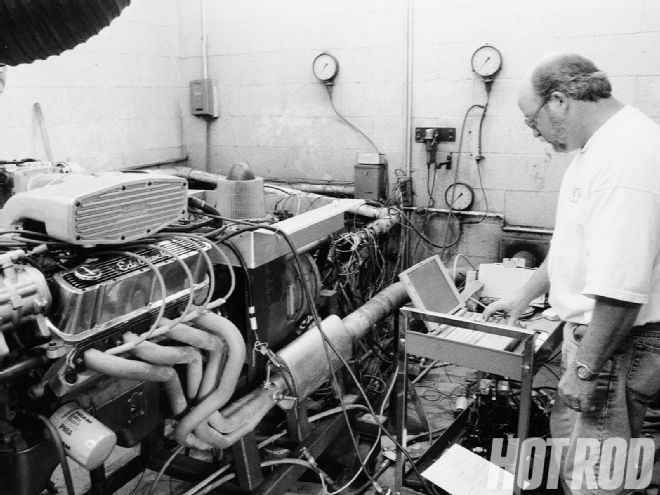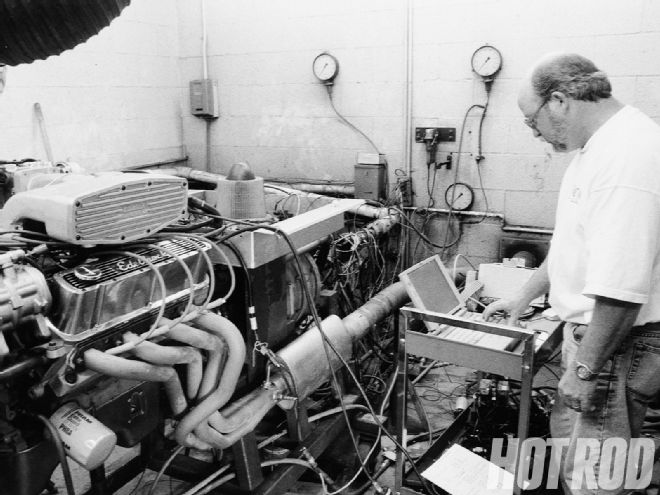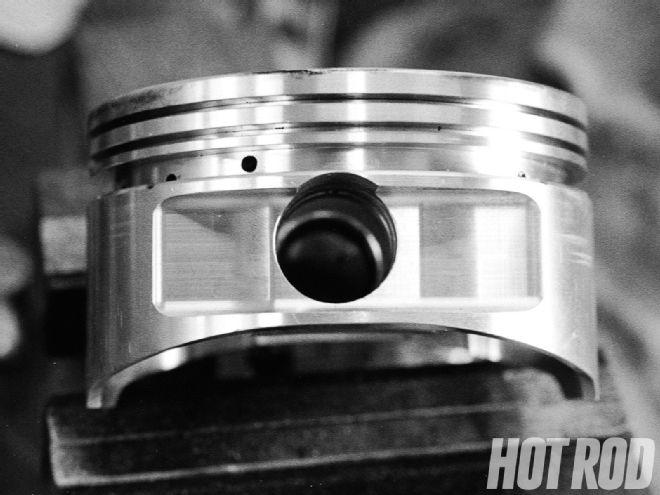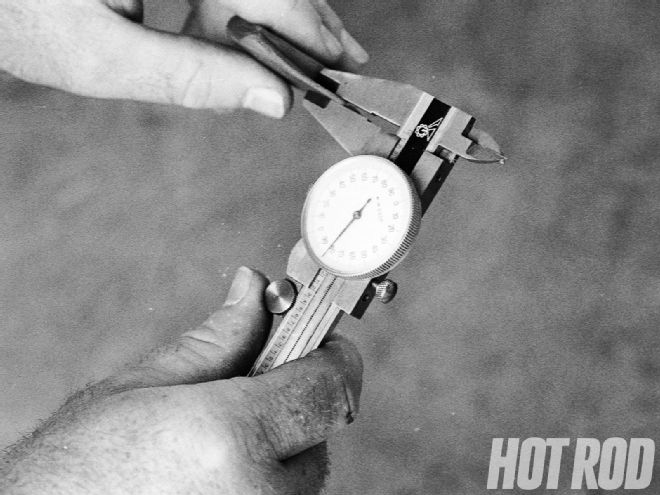
In the February '98 issue, we detailed the construction of a long-rod, high-compression Ford 351W V-8. Since this was a street-only engine, we purposely set our engineering goals very high. We required full emissions compliance, a factory-quality idle, and the inclusion of the Ford EEC-IV factory fuel-injection system to produce at least 400 hp and 400 lb-ft of torque. Further, we wanted to achieve peak power at 5,000 rpm and peak torque at 4,000 rpm. To all of you who anticipated the appearance of Part Two sooner, we extend sincere apologies. Considering the results, we think you'll find that the wait was worthwhile.
 Our 351W is emissions compliant, sports 11:1 compression, runs on 87-octane unleaded, and can be built by any hot rodder in his home garage. Ken Christley of Kenne-Bell checks the A/F ratio as delivered by the company's computer chip.
Our 351W is emissions compliant, sports 11:1 compression, runs on 87-octane unleaded, and can be built by any hot rodder in his home garage. Ken Christley of Kenne-Bell checks the A/F ratio as delivered by the company's computer chip.
Parts and Design
The basic engine theory and its components are detailed in the first installment of this two-part article, but we'll briefly restate the concept here. The key to our engine is unusually long (6.58-inch) connecting rods, 11.0:1 static-compression ratio, optimized fuel delivery and spark timing, and a wise selection and matching of the primary parts (see list). In a nutshell, longer rods allow the engine to make more power and to reduce its breathing needs, as well as its sensitivity to detonation, thereby allowing a relatively high static-compression ratio. A higher compression ratio elevates power and torque, and the reduced breathing relies on the long connecting rods to work better with OEM-type, air-limited intake systems and yield more go at low rpm levels.
The Problem with Factory Fuel Injection
The OE fuel injection posed three major engineering challenges: air, spark, and fuel delivery. First, let's look at providing optimum fuel delivery throughout the rpm band during wide-open throttle (WOT) and balancing it with the right amount of spark timing. Though the Ford EEC-IV mass-air SEFI system is very adaptable, in stock form it cannot make the substantial changes necessary to provide the optimum air/fuel ratio for a 400hp engine such as ours. Further, the EEC-IV system's WOT preprogrammed spark curve is non-adaptable. Without addressing these challenges, our highly modified 351W wouldn't perform at full potential with stock EFI.
 Offsetting the wristpins 0.090 inch yields a slight angle to the rod when the crank is at top dead center (TDC); this effectively eliminates the deadlock between the two as the piston starts to push downward. This small amount of rod angle at TDC helps push the crank over more easily and should add low rpm power and torque. The penalty is a little more cold-start piston noise, but there is no increase in cylinder-wall wear.
Offsetting the wristpins 0.090 inch yields a slight angle to the rod when the crank is at top dead center (TDC); this effectively eliminates the deadlock between the two as the piston starts to push downward. This small amount of rod angle at TDC helps push the crank over more easily and should add low rpm power and torque. The penalty is a little more cold-start piston noise, but there is no increase in cylinder-wall wear.
We found part of the solution at Kenne-Bell, in Rancho Cucamonga, California. The company supplied one of the few aftermarket chips available that can make the kinds of WOT fuel- and spark-timing changes needed by this offbeat engine combination. Traditionally, you couldn't attain these factors with "black box" factory EFI systems, but Kenne-Bell got into the factory computer and modified the WOT spark and the injector pulse control curves to deliver exactly what the motor needed. Since the company was involved in the development of this engine, it can supply the same chip we used.
In the matter of air delivery, even some aftermarket fuel-injection manifolds cannot pass the same amount of air that a good dual-plane carburetor manifold can deliver. To make matters worse, (according to engine-wizard Ken Duttweiler) the Ford 351W doesn't breathe as well as the Chevy 350, even in carbureted trim. Knowing this beforehand prompted us to enhance intake breathing from the start. Extrude-Honing the Edelbrock intake manifold, a 75mm throttle body, and an 85mm mass-air meter were all part of the path to power.
 We double-checked piston-to-valve clearance by putting clay on top of the pistons during the mock-up process and rotating the engine through a couple of cycles. Our design yields 0.125-inch clearance on the intake side, 0.235-inch clearance on the exhaust side, and about 0.055-inch squish clearance between the flat portion of the piston and the bottom of the heads. The small squish clearance (being measured here) improves combustion-chamber efficiency.
We double-checked piston-to-valve clearance by putting clay on top of the pistons during the mock-up process and rotating the engine through a couple of cycles. Our design yields 0.125-inch clearance on the intake side, 0.235-inch clearance on the exhaust side, and about 0.055-inch squish clearance between the flat portion of the piston and the bottom of the heads. The small squish clearance (being measured here) improves combustion-chamber efficiency.
Cylinder Heads
We tested with two different sets of heads on our long-rod 351W. The regular TFS Twisted-Wedge small-block heads flow 250 cfm of air, as determined by our own flow-bench testing at Duttweiler's. Although this is a good number, we also dyno-tested our prodigious 351W with the TFS "R" head, which passed a whopping 290 cfm. Normally, such a "large" head would give up tons of low rpm torque, but by using long rods, the normal way of thinking doesn't apply anymore. In fact, the bigger heads produced 20 hp more at the 5,000rpm peak and 20-plus lb-ft of additional torque at 4,000 rpm. In our analysis, the bigger heads could support a slightly longer camshaft with 4 to 5 degrees more duration. This would take a small amount of torque away from the 2,000- to 3,500rpm band, but it would add torque and power from 4,000 rpm and up.
Dyno Results
The 250cfm heads made 380 hp and 430 lb-ft of torque. The increased flow of the 290cfm heads made 400 hp and a 450 lb-ft of torque-these numbers are comparable to the best big-cube engines of the '60s musclecar era! When you consider that this was done using the Ford EEC-IV fuel-injection system with all its emissions strategies, 87-octane gasoline, a hydraulic roller cam that is but 10 degrees longer than a stock 5.0L late-model Mustang cam, and that the engine is emissions-legal, the results are all the more impressive.
Summary All in all, our long-rod SEFI 351W engine hit a grand slam, dispelling the notion that fuel injection offers good, cold start-up and driveability features, clean emissions, and respectable fuel mileage, yet it just can't keep up with a carburetor for power. We proved quite the opposite. Even with a good dual-plane intake and a streetable four-barrel carb, our 351W would have made about the same hp and would not have come close to the torque figure. By comparison, the hugely successful long-rod Chevy 352 we built for the June '97 issue made 413 hp and 430 lb-ft of torque in carbureted trim.
If you match the parts and assembly methods we used with our long-rod 351W, you can achieve the same power and torque figures. Since acceleration on the street is largely a function of torque, putting this anaconda under the hood of any car should result in the kinds of thrills and neck-snapping fun that only the musclecar era could deliver from a small-block-until now!
Dyno Results of 351W with TFS R Heads Engine rpm Torque Horsepower 2,500 367 175 2,600 377 187 2,700 385 198 2,800 383 204 2,900 382 213 3,000 386 220 3,100 394 234 3,200 391 238 3,300 419 263 3,400 416 269 3,500 428 285 3,600 431 295 3,700 435 307 3,800 436 315 3,900 455 338 4,000 458 349 4,100 449 350 4,200 453 362 4,300 455 372 4,400 449 376 4,500 443 380 4,600 440 386 4,700 436 390 4,800 433 396 4,900 427 399 5,000 421 401 5,100 411 400 5,200 400 396 5,300 382 385 5,400 367 378 5,500 351 367
Dyno results prove the value of long rods and show that with the right combination of parts and calibration, factory EFI can match a carburetor for power. A heavy vehicle or one equipped with an automatic transmission requires a lot of low-rpm torque to provide neck-snapping acceleration. It is clear that our long-rod 351W is an ideal candidate for this. The torque curve is bountiful and fat, which means the engine will be very tractable on the street.
Effects of Restricted Inlet Air with Standard
Heads
Small
Intake Tube
Large
Intake Tube
Engine rpm
Torque
Horsepower
Torque
Horsepower
2,500
378
180
379
180
2,600
384
190
386
191
2,700
401
206
400
205
2,800
416
222
419
225
2,900
412
228
414
230
3,000
409
234
409
234
3,100
406
240
406
240
3,200
406
247
405
246
3,300
422
265
422
265
3,400
427
276
427
276
3,500
426
284
426
285
3,600
422
289
421
289
3,700
419
295
419
294
3,800
422
305
420
303
3,900
425
316
425
315
4,000
427
325
427
325
4,100
428
334
428
335
4,200
431
344
431
344
4,300
428
350
430
352
4,400
423
354
425
358
4,500
415
355
422
361
4,600
410
358
418
366
4,700
403
361
414
371
4,800
396
362
409
374
4,900
390
364
405
378
5,000
384
365
400
380
5,100
376
365
389
378
5,200
365
362
376
373
5,300
354
357
363
366
5,400
342
351
349
358
5,500
322
339
328
345
These curves clearly demonstrate how sensitive the 351W engine is to intake breathing. The universal replacement air-inlet tube stocked by Ford cut the peak power by more than 15 hp, even with the small heads. Switching to an original '86 Mustang tube boosted power significantly and didn't hurt torque at all. With further improvements to intake breathing, the small-head version of our 351W could undoubtedly surpass 400 hp, though we imagine torque would max out at around 430 lb-ft.
Long-Block Parts Part Description Source Block: Stock two-bolt 351W, bored 0.030-inch oversize Local Crank: Stock 351W crank modified for long rods Wayne's Engines Rods: Ford 400-cid modified for 0.866-inch floating pins and 351W crank, with ARP rod bolts Wayne's Engines Bearings: 0.010-inch oversize main (PN MS-1432), 0.030-inch oversize rod bearings (PN CB-927) AE Clevite Pistons: 415-gram dished forging with 0.866-inch pin (PN 139105) JE Pistons Rings: Pregapped 0.030-inch oversize moly (PN R-9902) Speed-Pro (Dana) Gaskets: Overhaul kit with no-retorque head gasket (KS2329) Fel-Pro Cam and lifters: Hydraulic roller cam, 220-degree duration (PN 444131), hydraulic retrofit roller lifters (PN 36532) Crane Cams Pushrods: 7.635-inch hardened steel for standard head (PN 11636), 7.335-inch hardened steel for R head (PN27638) Crane Cams Rockers: 1.7:1 aluminum needle bearing rollers (PN 36757) Crane Cams Rocker studs: 7/16-inch 20 top, 7/16-inch 14 bottom screw-in (PN 99151) Crane Cams Oil pump: High-volume (PN 224-102R ) Speed-Pro Heads: Twisted Wedge, 2.02-inch/1.60-inch valves (PN TFS-51400002), Twisted Wedge R head, 2.080-inch/1.60-inch valves (PN TFS-52400002) milled 0.070-inch Summit Racing Intake: Extrude-Honed (290 cfm per runner) Edelbrock Performer (upper); 351W truck lower; two GGK Phenolic spacers Edelbrock
The entire long-block can be assembled for about $3,000 if you use the standard Summit TFS Twisted-Wedge head. The basic long-block price increases to about $3,800 if you opt for the "R" heads. Compared to what you have to pay for a carbureted crate engine, this is still pretty inexpensive, considering the power and torque the 351W can deliver with fuel injection in a fully emissions-compliant form.
Fuel and Spark Delivery at WOT Engine rpm Total Ignition Timing (degrees) Injector Pulse Percentage 2,500 26.5 81.5 2,750 27.5 85.0 3,000 28.0 86.5 3,250 28.0 88.0 3,500 29.5 89.0 3,750 29.5 90.5 4,000 29.5 91.5 4,250 30.0 92.0 4,500 30.0 92.0 4,750 31.0 91.5 5,000 31.5 91.0 5,250 32.0 89.0 5,500 32.0 87.0 5,750 32.5 83.5
All other things being equal, the less timing an engine needs to make maximum power, the more efficient the combustion chambers are. Our engine only needed 32 degrees of total timing to produce maximum power. By comparison, most old-technology small-block Fords (and Chevys) need 35 to 40 degrees of total timing; again a measure of how efficient our long rods and optimized combustion chambers are.